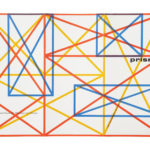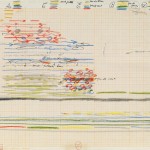
The stark urgency and clean lines of their prose mirrored the light-metal severity of groups like Wire, the Banshees, and Gang of Four, just as the record design aesthetic of the time emphasized a bold, bracing geometry of hard angles and primary-color blocks.
Simon Reynolds – Rip it up and start again, postpunk 1978-1984
A former student of textiles and freelance designer before joining the band, the bass player for the seminal post-punk band Wire, Graham Lewis not only formed a writing partnership with Colin Newman, acting primarily as lyricist, but he created much of Wire visual identity, including record sleeves and stage design.
Here follows a collection of the band’s cover design for LP, 45’s and live albums. (*).

Wire’s design sensibility encompassed the striking cover art on their records (the concept invariably devised, if not executed, by Gilbert and Lewis) and their highly contoured and geometric music. Even at its most punklike, there was a brutal elegance to the power chords and riffs. One could almost visualize their music as clean lines, deliberate spacings, and blocks of texture. The name Wire itself was chosen as much for “its graphic quality,” says Lewis, as for its connotations (thin and metallic, electrical power lines). “It was short and stark and would look big on a poster even if we were bottom of the bill!” (…)
What made Wire punk was their minimalism, their reductionist disdain for extraneous decoration. Initially, they arrived at their sound through removals and refusals. “It was a process of elimination, all the things we don’t do,” recalls Newman. “At the end of the process, the list of things we actually did do was quite short!” (…) “All the fat, all the meander, suddenly disappeared,” says Newman. “Everything was edited down drastically, the songs came down to one and a half minutes long.”
Wire’s lyrics, mostly written by Graham Lewis, were no less process oriented. His words for “106 Beats” came out of a failed attempt to write a lyric that only had one hundred syllables in it. “It turns out it’s got one hundred six, but that doesn’t matter because you’ve created a process.” He and Bruce Gilbert would play absurdist games with sense and nonsense, narrative and fragmentation.
Because making statements or self-expression wasn’t the point, nobody was precious about the words. They were simply material to be messed around with. For instance, Newman wrote a lyric about a lion tamer, which Lewis mostly didn’t care for, so he went through replacing all the bits he didn’t like. Hence the song’s eventual title, “Ex Lion Tamer.” Dismembering sequential narrative
was a favorite Lewis tactic.The kaleidoscopic perceptions in Wire songs often managed to be closer to the fractured way we actually experience reality. (…)
Newman’s “Two People in a Room” depicted emotional conflict as stratagem and maneuver (“Positions are shifted/The cease-fire unlifted”) and obliquely evoked the disintegration of Wire into rival aesthetic camps. Ideas relating to number, measurement, and cartography limned the record, from songs such as “The 15th” and “Map Ref. 41°N 93°W” to the album title itself.
Symon Reynolds – Rip it up and start again, postpunk 1978-1984



































Further info on Wire on pinkflag.com
(*): We cannot be 100% sure that all the covers shown here have been designed by Graham Lewis. Please provide specific information if one or more cover design aren’t his.
Photographs of Wire’s IBTABA via Version Crazy





this is a great post! I’ve been a big fan of the Wire and especially of their aesthetic